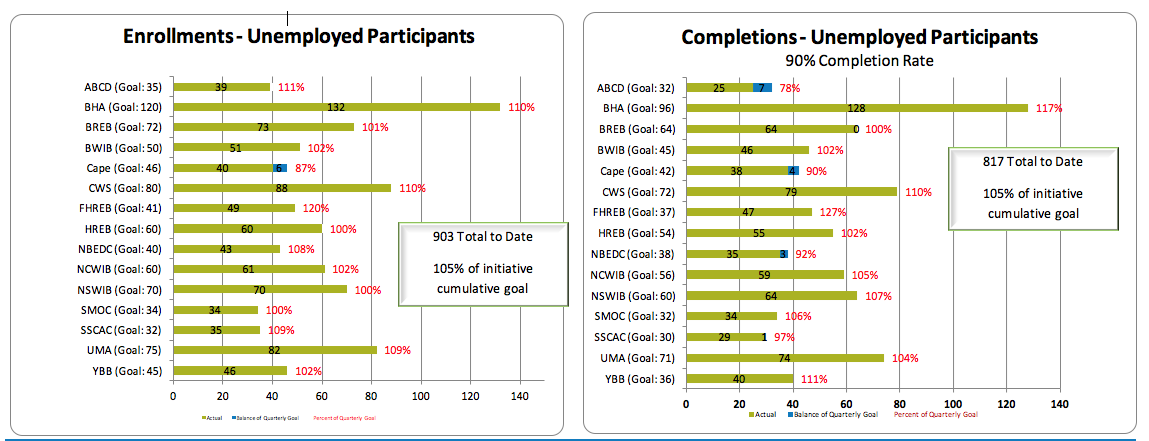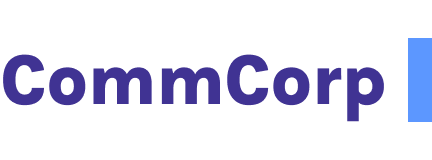Como Nancy presentó, esta es la segunda de cuatro publicaciones en nuestra serie de blogs Spring WCTF, Lograr resultados impactantes: observaciones de WCTF. En la publicación de hoy, Theresa Rowland, directora del programa, hablará sobre lo que significa estar basado en datos.
What does data driven-mean? And how do programs ensure they are doing it? To us, data-driven is identifying and using data to help make decisions about the programs we fund. In my 10 years of experience at CommCorp, I have come to learn the value of being data-driven. We ask partnerships to be data-driven from the beginning of any program by engaging employers to identify local real time demand for target occupations. Partnerships are required to talk with employers in their region who are hiring for their identified target occupation, and then learn everything they can about the employers’ skill, credential and hiring requirements. While publicly available data sets are helpful in figuring out which employers to start to talk with, building the case for the demand and need for a training program is only made by talking with real local employers who can provide information on the number of vacancies they currently have, the number they anticipate needing to fill over the next 1-2 years and are committed to partnering to fill their vacancies. We also ask partnerships to continue to be data-driven in managing and measuring the success of their programs. It helps that we are very clear on the goal of sector strategies programs – to place participants in stable positions with opportunities for advancement. Partnerships propose goals and track data using a participant level database for the following indicators:- Objetivo principal: colocación laboral
- Indicadores provisionales:
- Inscripción
- Obtención de credenciales
- Finalización del entrenamiento
 El tablero no responde todas nuestras preguntas, pero nos ayuda a orientarnos en la dirección correcta para comenzar a explorar la causa raíz del problema y comenzar a identificar las correcciones a mitad de camino. Por ejemplo, una baja tasa de obtención de credenciales puede indicar una variedad de problemas, incluido el plan de estudios de capacitación que no está alineado con el examen de acreditación, un lapso de tiempo significativo entre la fecha de finalización de la capacitación y el examen de acreditación o barreras de lectoescritura o aritmética. Los datos nos alertan sobre un problema potencial que requiere exploración y conversación adicionales para comprender.
El tablero no responde todas nuestras preguntas, pero nos ayuda a orientarnos en la dirección correcta para comenzar a explorar la causa raíz del problema y comenzar a identificar las correcciones a mitad de camino. Por ejemplo, una baja tasa de obtención de credenciales puede indicar una variedad de problemas, incluido el plan de estudios de capacitación que no está alineado con el examen de acreditación, un lapso de tiempo significativo entre la fecha de finalización de la capacitación y el examen de acreditación o barreras de lectoescritura o aritmética. Los datos nos alertan sobre un problema potencial que requiere exploración y conversación adicionales para comprender.
 Another dashboard used to make program decisions is the demographic report. This helps us understand more about the individuals being served by the programs we fund. We can even look at whether there are certain populations achieving higher rates of employment outcomes by program to help understand any relationship between the demographic profile of an individual and their likelihood of entering employment. This is an important data point to ensure programs are working to support all program participants. For example, if a program was placing a lower proportion of individuals without a high school diploma than individuals with a high school diploma, the program may want to review their selection criteria or design an additional component of the program to provide additional literacy skills to this population.
Data-driven is more than just crunching some numbers. The real fun is using data to point you in the direction toward meaningful conversations with program participants and partners to understand what is really going on in your programs and how to make mid-course corrections to ensure your program meets your partnership’s goals.
Escrito por Theresa Rowland, Directora del Programa de Iniciativas Sectoriales de Empleo en Commonwealth Corporation. Theresa ha trabajado durante los últimos 10 años otorgando y administrando subvenciones a través del Fondo Fiduciario para la Competitividad de la Fuerza Laboral.
Another dashboard used to make program decisions is the demographic report. This helps us understand more about the individuals being served by the programs we fund. We can even look at whether there are certain populations achieving higher rates of employment outcomes by program to help understand any relationship between the demographic profile of an individual and their likelihood of entering employment. This is an important data point to ensure programs are working to support all program participants. For example, if a program was placing a lower proportion of individuals without a high school diploma than individuals with a high school diploma, the program may want to review their selection criteria or design an additional component of the program to provide additional literacy skills to this population.
Data-driven is more than just crunching some numbers. The real fun is using data to point you in the direction toward meaningful conversations with program participants and partners to understand what is really going on in your programs and how to make mid-course corrections to ensure your program meets your partnership’s goals.
Escrito por Theresa Rowland, Directora del Programa de Iniciativas Sectoriales de Empleo en Commonwealth Corporation. Theresa ha trabajado durante los últimos 10 años otorgando y administrando subvenciones a través del Fondo Fiduciario para la Competitividad de la Fuerza Laboral. 
